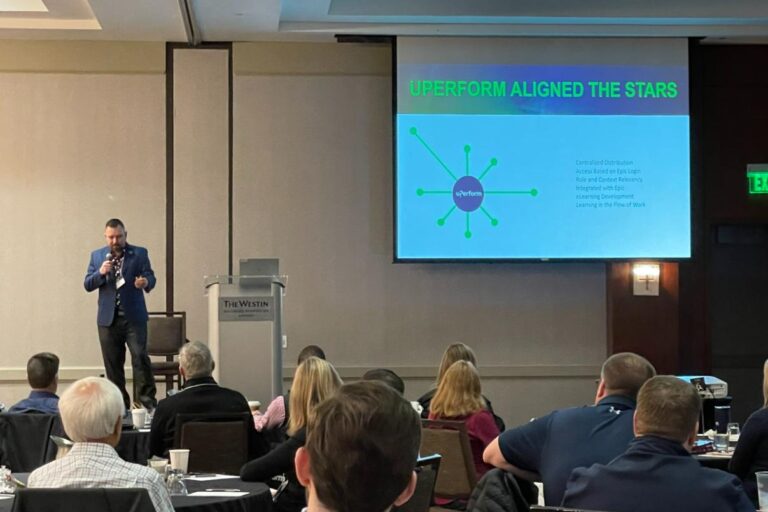A lot of people are working hard to improve the healthcare experience for patients and providers alike. And that’s a great thing. However, it also means that training teams are competing for the resources and budget they need to advance their mission.
We hosted a panel of clinical IT leaders for a discussion on how to get on the radar of your leadership and advocate for additional training resources. The panelists included:
- Dr. Annabaker Garber, CNIO, HCA Healthcare
- David Kwo, former CIO of several NHS trusts
- Dr. David Butler, CEO at Calyx Partners and EHR implementation expert
- Dr. CT Lin, CMIO at UCHealth (a uPerform client)
Each panelist brought decades of experience with EHR implementations and clinical leadership to the discussion. They emphasized the importance of effective EHR education, the impact of training on clinician satisfaction and efficiency, the potential of training to enhance patient experience and operational efficiency and the strategies training leaders can leverage to communicate these values to organizational leadership.
If you’re looking to prioritize education and garner additional resources for training at your organization, here are some of the tips our experts recommend:
1. Tell a story
Sometimes it’s easy to get so caught up in the data that we forget our overall narrative. Our panelists caution against this. They all agree that telling a story and sticking to your narrative is arguably more important than the data you present.
Perhaps Dr. Lin summed it up best by saying “No one changes their mind because of a number; they need a story.”
Dr. Butler adds to this by suggesting that training leads think like marketers when promoting their training programs. “Facts tell, stories sell,” says Butler.
When considering your approach to leadership, consider incorporating real-life success stories. Here are a few examples of stories uPerform clients have shared with us:
- When M Health Fairview was facing one of the largest nursing strikes in the nation, a course they created with uPerform helped them onboard 1,500 nurses in only five days.
- A UCHealth survey of affiliate providers showed 90% of respondents felt training prepared them to use the EHR and they preferred the self-paced learning format.
- With self-paced learning, Gundersen Health was able to free up training resources to allow more one-on-one coaching and personalization training.
2. Back your story up with data
While it’s best to lead with a story, backing it up with data is still important. David Kwo emphasizes this, adding “It’s really about having a narrative that captures the imagination of your executives and having the data to back it up.” He notes that this is a particular emphasis in the UK, as the NHS makes significant investments in its digital transformation.
3. Take account of the milestones in your journey
When telling your story, Dr. Lin recommends that you take account of and include the milestones along your journey. He alludes to the sacred bundle, a wrapped collection of items used in Indigenous American ceremonial cultures to represent their journey and shared experiences.
“And I would suggest that your sacred bundle ought to be that one clinician that really benefited. Or the reverse, the negative sacred bundle story. That high-powered surgeon who you recruited from across the country and came in on a Monday, but you couldn’t send a trainer until Friday, because they’re 200 miles away and you’re full up. No one is happy and this very expensive surgeon is sitting unproductive for a week, because you couldn’t do on-the-fly training.”
4. Focus on how you’re helping the organization, not what you’re ‘doing’
Dr. Garber recommends that as you tell your story, focus on how you’re helping the organization:
“Nobody really cares how many classes, courses, curricula, tip sheets you do; what they’re interested in is the impact of that. So, the more stories you can tell about the impact, and the more that impact lines up to what the goals of the organization are, that’s when it becomes a strategic priority.”
5. Align training with organizational objectives and clinical outcomes
The panelists also recommend that you align your training goals with that of the organization. Dr. Garber outlines the two main priorities of any healthcare organization:
- Delivering patient care faster, better, and more reliably
- Taking care of the mental health and the environment that clinicians are working in
“The work that you’re doing has a pivotal role in the mental health of your clinicians and in the operational efficiency of delivering care,” she emphasizes.
6. Leverage clinician testimonials
Dr. Garber also recommends that training leads leverage the feedback they receive from clinicians when appealing to leadership.
“Nothing influences the leadership more than testimonials from your clinicians.”
Testimonials from your clinicians help tell your narrative to executive leadership and emphasize the value of the work training teams provide.
7. Learn from other departments
Are there other departments within your organization that seem to be getting the funding they need? Dr. Butler suggests learning from them and borrowing some of their tactics when appealing to leadership for additional funding.
“Make sure you use the techniques that other departments that always get funding use.”
Related Articles
Tell your story with the help of uPerform
Need a training success story worth sharing? Health systems nationwide are reducing time and costs associated with training, increasing adoption of new workflows and driving EHR satisfaction with the help of uPerform. uPerform delivers role-based, bite-sized learning opportunities to users within their workflow, so clinicians always have the support they need when they need it.
Contact us today to learn more!







